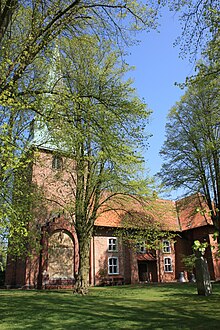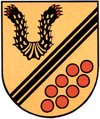Asendorf (district of Diepholz)
| coat of arms | Germany map | |
|---|---|---|

|
Coordinates: 52 ° 46 ' N , 9 ° 0' E |
|
| Basic data | ||
| State : | Lower Saxony | |
| County : | Diepholz | |
| Joint municipality : | Bruchhausen-Vilsen | |
| Height : | 48 m above sea level NHN | |
| Area : | 58.16 km 2 | |
| Residents: | 2975 (Dec. 31, 2019) | |
| Population density : | 51 inhabitants per km 2 | |
| Postal code : | 27330 | |
| Area code : | 04253 | |
| License plate : | DH, SY | |
| Community key : | 03 2 51 002 | |
| Community structure: | 8 districts | |
| Association administration address: | Lange Strasse 11 27305 Bruchhausen-Vilsen |
|
| Website : | ||
| Mayor : | Heinfried Kabbert ( Independent Voting Association Asendorf (UWG) ) | |
| Location of the community of Asendorf in the district of Diepholz | ||
Asendorf ( Low German Asendörp ) is a rural municipality in the bruchhausen-vilsen in Diepholz in Lower Saxony .
geography
location
The community is located 36 km south of Bremen and is the second largest place in the integrated community .
Community structure
Asendorf is made up of the following districts:
- Asendorf (core town)
- Brebber
- eat
- Gray ones
- Haendorf
- Hohenmoor
- Kuhlenkamp
- Uepsen
history
Place name
The place was named Asenthorpe in 1252 and Asendorpe in 1330 . Aso as a personal name could go back to the Germanic Ans and thus to the term Asen , the pagan gods of the Teutons . Anso, Aso, Aaso, Asso, Oso, Osso are attested in written sources since the 8th century. The name could also be of Longobard origin, since the Longobards are said to have had a personal name Aso or Anso .
Local history
The place was first mentioned in a document in 1091. The charter refers to events that happened a few years earlier. Gerhard II von Stumpenhusen was once supposed to cede seven farms and eight serfs in Asendorf as well as four other farms in Uepsen to the church . He was allegedly banned by the princes of the church and betrayed them because he only ceded four farms from Asendorf and two from Uepsen. The church in Achim brought him to court because of the fraud and the debt of farms and serfs. The presidency was held by the highest church prince in the region, Archbishop Liemar von Bremen , and his vassal, Duke Magnus, who held the royal spell. Among the knights of the archbishop were, in addition to the duke, the then still young Margrave Udo (Luder-Udo III.), Son of Margrave Udo , the then Vogt of the Bremen church Count Friedrich, Count Ekbert, Count Egilmar , Count Lambert of Westphalia, Adolf, the brother of Gerhard von Stumpenhausen, Dietrich Sueuus , the brother of Archbishop Mazellin and his son Adalbero, the noble youth Udo von Westfalen and a Folkbert present; of the knights of Duke Count Heinrich von Hamburg , Count Reinhold and Hermann von Imina ; of the knights of Margrave Gerbert, another brother of Gerhard von Stumpenhausen and Ulrich von Stade as well as numerous free and ministerials of the Bremen church; together more than 300.
At the time, Asendorf was already a Kerkspeel with the presbyter Lambertus, so the church must have already existed as a building at that time. The village was built well before that, but the official 900th anniversary was celebrated in 1991.
There is evidence of a parish church around 1250 ("parochia in Asenthorpe") and it was mentioned in the church records in the 16th century:
The St. Paul monastery in front of Bremen, to which the Asendorfer church belonged, refused to pay off the debts that had arisen from the occupation of the county of Hoya by the dukes of Braunschweig-Lüneburg . Count Jobst II. Von Hoya subsequently confiscated the goods of the monastery in Asendorf.
In 1524 the tower of the St. Marcellus Church was built and the nave was extended. In 1778 the church was renovated and in 1909 the two transepts and the apse were added. Between 1950 and 1964 there was a complete renovation with painting of the interior of the church.
In 1898 the Hoya-Syke-Asendorf small railway came , which was expanded in 1900 by the Bruchhausen-Vilsen-Asendorf-Bruchhausen-Vilsen line. Asendorf station is today the end point of Germany's first museum railway . Today's federal road B 6 was already laid out from Syke to Wietzen in 1771, but not yet paved; it was only completed between 1810 and 1826.
Since 2001 the place has been funded by the Lower Saxony village renewal program.
Incorporations
The joint municipality of Asendorf was dissolved for regional reform in Lower Saxony on March 1, 1974 and merged with the communities of Brebber, Essen, Graue, Haendorf, Hohenmoor, Kuhlenkamp and Uepsen to form the rural municipality of Asendorf.
Population development
|
|
|
¹ census results from June 6th (territory of today's municipality)
² census results from May 27th (territory of today's municipality)
³ as of December 31st

|
politics
Municipal council
The council of the municipality of Asendorf consists of 12 council members. This is the specified number for the member municipality of an integrated municipality with a population between 2001 and 3000 inhabitants. The council members are elected for a five-year term by local elections. The current term of office began on November 1, 2016 and ends on October 31, 2021.
The mayor is also entitled to vote and sit on the council.
The last local election on September 11, 2016 resulted in the following:
- Independent constituency of Asendorf (UWG) : 5 seats
- CDU : 4 seats
- SPD : 2 seats
- Greens : 2 seats
(Status: local election on September 11, 2016)
Two council members (UWG, Greens) have already terminated their membership.
mayor
The mayor of the community of Asendorf is Heinfried Kabbert (UWG). His deputy is Jens Grimpe (SPD).
coat of arms
| Blazon : “In gold, covered with gold twin strips, lowered, black oblique left bar ; at the top two upright averted, red armored , black bear paws connected by a pieceat the bottom, at the bottom 8 (1: 2: 2: 2: 1) obliquely left , round, unminted, red coins . | |
Reasons for the coat of arms: The brochure for new and old citizens states the following:
|
Culture and sights
Buildings
- The St. Marcellus Church is a church hall in brick , in the core of the Middle Ages comes.
Art exhibitions
The art shed Asendorf was opened in 2010 in a former storage shed directly on the tracks of the museum railway at Asendorf station. In the rustic ambience of a half-timbered shed, changing artists present their works on an area of approx. 220 m². The operator is the art track .
Museums
- The Asendorf car museum was opened in 1980. Around 60 vehicles will be exhibited, mainly small cars.
- Lower Saxony Small Railway Museum (Museum Railway Bruchhausen-Vilsen-Asendorf), the first museum railway in Germany, a narrow-gauge railway with 1000 mm gauge. It is operated by the German Railway Association .
Wismar rail bus in the Asendorf locomotive shed of the museum railway
traffic
The federal highway 6 Hannover – Bremen leads directly through the community. In addition, Asendorf is on the Bruchhausen-Vilsen-Asendorf railway line , which is used by museum traffic.
Personalities
Sons and daughters of the church
- Heinrich Hünecke (1891–1971), sports teacher, sports official and administrative officer, he was the first President of the Lower Saxony State Sports Association and founding vice-president of the German Sports Association, born in the Brebber district
- Bernhard Diers (* 1959), cook
People connected to the community
- David Heinrich Hoppe (1760–1846), physician, botanist and pharmacist, and entomologist; a road (David-Hoppe-Weg) that leads from Bruchhausen-Vilsen to Asendorf was named after him
- August von Arnswaldt (1798–1855), landowner in Hardenbostel, writer
- Louis Victor Stegemann (1830–1884), landowner in the Essen district, member of the Reichstag
- Hermann von Arnswaldt (1841-1910), landowner in Hardenbostel, member of the Reichstag ( German-Hanover party )
- Hermann Benjes (1937–2007), landscape gardener, nature photographer and writer, died in Asendorf
- Bärbel Rädisch (* 1942), author, lives in the Hohenmoor district
- Bernhard C. Wintzek (1943–2018), right-wing extremist and later right-wing conservative publicist, died in Asendorf
- Wolfram Bäumer (1959–2017), railway engineer and museum railway specialist, he worked for the German Railway Association, which operates the narrow-gauge railway line Bruchhausen-Vilsen-Asendorf as a museum railway
- Cord Bockhop (* 1967), local politician (CDU), he has been the district administrator of the Diepholz district for eight years since 2011, he grew up in the Graue district
See also
Web links
- Homepage Asendorf
- History of the church
- History of Asendorf
- Museum railway between Bruchhausen-Vilsen and Asendorf
- Homepage of the art shed Asendorf
- Historical postcards from Asendorf
Individual evidence
- ↑ State Office for Statistics Lower Saxony, LSN-Online regional database, Table 12411: Update of the population, as of December 31, 2019 ( help ).
- ^ Jürgen Udolph (research): The "place name researcher". In: Website NDR 1 Lower Saxony . Archived from the original on December 7, 2015 ; accessed on August 2, 2019 .
- ↑ a b c Federal Statistical Office (ed.): Historical municipality directory for the Federal Republic of Germany. Name, border and key number changes in municipalities, counties and administrative districts from May 27, 1970 to December 31, 1982 . W. Kohlhammer, Stuttgart / Mainz 1983, ISBN 3-17-003263-1 , p. 191 .
- ↑ a b c d Michael Rademacher: German administrative history from the unification of the empire in 1871 to the reunification in 1990. County Grafschaft Hoya ( see under: No. 6 ). (Online material for the dissertation, Osnabrück 2006).
- ^ Ulrich Schubert: Community directory Germany 1900 - district Hoya. Information from December 1, 1910. In: gemeindeververzeichnis.de. January 5, 2020, accessed January 16, 2020 .
- ↑ a b Statistisches Bundesamt Wiesbaden (ed.): Official municipality register for the Federal Republic of Germany - 1957 edition (population and territorial status September 25, 1956, for Saarland December 31, 1956) . W. Kohlhammer, Stuttgart 1958, p. 156 ( digitized version ).
- ↑ Lower Saxony State Administration Office (ed.): Municipal directory for Lower Saxony . Municipalities and municipality-free areas. Self-published, Hanover January 1, 1973, p. 21 , County of Hoya County ( digitized [PDF; 21.3 MB ; accessed on January 16, 2020]).
- ↑ a b c d e f g h i j k l m n o p q r s municipality directory - archive - regional structure - annual editions - Lower Saxony. (All politically independent municipalities in EXCEL format). In: Destatis website. Federal Statistical Office, accessed on January 16, 2020 .
- ↑ a b c d e Asendorf City Council. In: ratsinfosystem.bruchhausen-vilsen.de. Retrieved January 16, 2020 .
- ^ Lower Saxony Municipal Constitutional Law (NKomVG); Section 46 - Number of Deputies. In: Lower Saxony Regulations Information System (NI-VORIS). December 17, 2010, accessed January 16, 2020 .
- ^ Result of municipal election Asendorf 2016. In: bruchhausen-vilsen.de. September 11, 2016, accessed January 16, 2020 .
- ↑ a b brochure for new and old citizens of the community of Asendorf. (PDF; 5.6 MB) In: drupal.asendorf.info. Retrieved January 16, 2020 .
- ↑ Main statutes of the community of Asendorf. (PDF; 30 kB) § 2; Coat of arms, flag, official seal; Paragraph 1. In: bruchhausen-vilsen.de. November 30, 2011, accessed January 16, 2020 .







